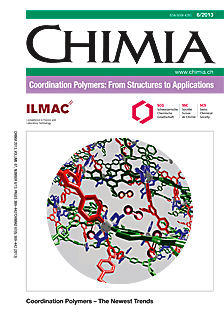Crystal Engineering of FeII Spin Crossover Coordination Polymers Derived from Triazole or Tetrazole Ligands
DOI:
https://doi.org/10.2533/chimia.2013.411Keywords:
Iron(ii) coordination polymers, Metal organic frameworks, Molecular bistability, Spin crossoverAbstract
The past decade has witnessed intense research activity in the area of FeII spin crossover coordination polymers, which are structurally diverse and functionally intriguing materials. In this endeavor, a less exploited series of ligands have been selected among various N-donor triazole and tetrazole molecules. Developing conventions that allow the tailoring of such functional materials with predictable architecture and properties is an important objective and current interest in crystal engineering. However, detailed knowledge on the structure–property correlation is still scanty due to the small number of crystal structures of such compounds. The principal focus is to decipher the effect of various supramolecular factors such as intermolecular interactions, hydrogen bonding etc., on the resultant FeII coordination polymers. This tutorial review aims at highlighting some of the developments of such structurally diverse and functionally intriguing 1D polymeric chains, 2D and 3D networks built from triazole or tetrazole ligands exhibiting fascinating spin crossover phenomena.Downloads
Published
2013-06-26
Issue
Section
Scientific Articles
License
Copyright (c) 2013 Swiss Chemical Society

This work is licensed under a Creative Commons Attribution-NonCommercial 4.0 International License.
How to Cite
[1]
Chimia 2013, 67, 411, DOI: 10.2533/chimia.2013.411.







